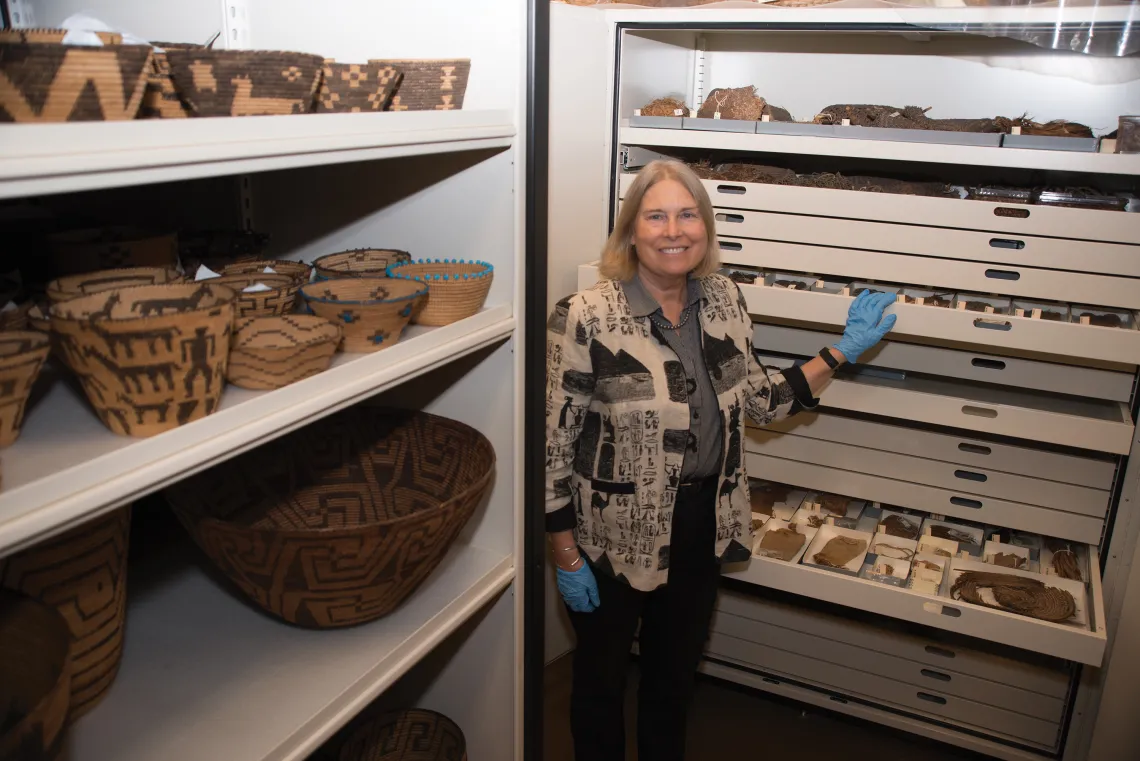
Odegaard in the ASM basketry vault in 2018.
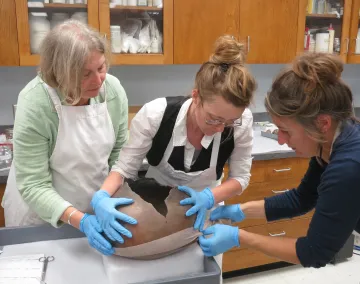
ASM’s state-of-the-art conservation lab and preservation program attracts students from all over the world each year. The ASM Preservation Division, under the leadership of Dr. Nancy Odegaard (left), provides dynamic research opportunities and real-world educational experiences for a fleet of interns, visiting scholars, undergraduate and graduate students, and volunteers. Pictured here is one of the lab's current interns, Betsy Burr and Nicole Peters working together to treat an unstable ceramic vessel.
Laboratory as Classroom
As an educator, Odegaard regularly included interns, students, and volunteers in museum projects such as collection assessment surveys, object technical studies, on-site archaeological stabilization, outdoor sculpture maintenance, and disaster recovery.
Hundreds of interns from around the world have been trained by her and have honed their skills in the lab through hands-on work. Scores of University of Arizona students in American Indian studies, anthropology, architecture, art, art history, biology, chemistry, classics, history, and materials science have learned about the care of hand-crafted objects through semester-long classroom instruction or independent study.
A wide range of collective expertise has made ASM’s conservation lab a popular resource for information and assistance. Odegaard has shared her research with the world through in-person training, books, chapters, journal articles, videos, conference presentations, oster sessions, public lectures, workshops, and behind-the-scenes tours.
Over the years, the quality, quantity, and far-reaching impact of Odegaard’s research, teaching, leadership, and mentorship have been recognized by numerous local, national, and international organizations, including the American Institute for Conservation. In 2016, she received an honorary doctorate from the University of Gothenburg in Sweden.
“Because of Nancy, ASM’s conservation lab is a shining example of research and professional training, of collaborative and interdisciplinary work, and of teaching and public service,” said Patrick Lyons, director of the Arizona State Museum. “Nancy is famous for identifying problems, researching solutions, establishing protocols, and disseminating information. She’s brilliant and tireless—a sheer force of nature.”
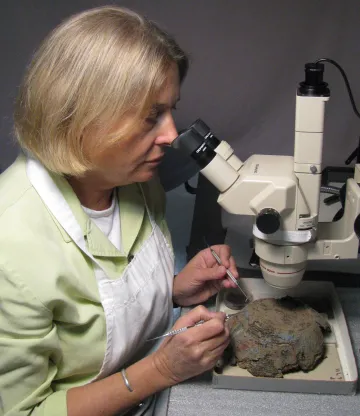
Research conducted in the lab resulted in:
• 77 chemical characterization tests for objects of art, archaeology, and architecture
• nine chemical identification tests, guidelines for mitigation, and several remediation methods for pesticide residues on museum objects
• conservation techniques for archaeological excavations and the general collection care procedures for archaeological and ethnological objects, especially ceramics and basketry
• guidelines for tribal consultations and collaborations; curricula for conservation science students; and curricula for the care and handling of anthropology collections
• protocols for analysis, cleaning, stabilization, and exhibition of museum objects, including pottery, basketry, brain-tanned leathers, and textiles.
___________________________________
Bugs, Poisons, and Heavy Metals
For more than 100 years, anthropology museums were rife with health hazards through the use of arsenic and mercury to preserve organic materials within their collections.
When Odegaard first came to ASM in 1983, she immediately faced a large and recurring insect infestation problem—not uncommon in collections of organic materials. Instead of using harsh chemicals as had been standard practice, she developed a better, more cost effective, and completely benign way to address that issue—deep freezing. Through a three-step process of freezing, thawing, and re-freezing, all stages of bug life are killed. Now, deep freezing is used by museums around the world.
After 1990, with the Native American Graves Protection and Repatriation Act (NAGPRA) mandating the return of ceremonial objects to Native communities, Odegaard immediately recognized the health risks. Objects that had been treated with poisons in the early part of the 20th century—masks, headdresses, and robes, for example—were going to go back to tribal communities, and many would be put back into ceremonial use. This meant they might be worn again. Odegaard took action to alert tribal colleagues to these risks, to establish protocols to test for and identify toxic residues, and to develop new and non-destructive ways to remove them—some of which resulted in patent applications. Ultimately, she co-authored and published Old Poisons, New Problems: A Museum Resource for Managing Contaminated Cultural Materials (AltaMira Press, 2005).Other important manuals by Odegaard include A Guide to Handling Anthropological Museum Objects (Western Association for Art Conservation, 1991), Materials Characterization for Objects of Art and Archaeology (Archetype Books, 2000), and Human Remains: Guide for Museums and Academic Institutions (AltaMira Press, 2006).
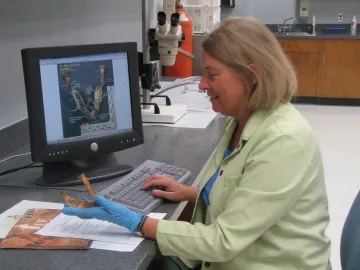
Odegaard examining a cast of “Lucy’s” jawbone.
___________________________________
National Impact
Odegaard is regularly called upon by other cultural institutions. Too numerous to list, some of her more notable consultations include the following:
- Odegaard helped create the format and standards for the Collection Assessment for Preservation Program (CAP) and has completed more than 75 surveys for this and other museum assistance programs around the country.
- Because of her respectful strategies for the care and treatment of ancient human remains, she was asked to advise on the preservation of the individual referred to as “Kennewick Man,” exposed in 1996 in Washington state (reburied in 2017).
- In 2005, in the aftermath of Hurricane Katrina, Odegaard, who at the time was president of the American Institute for Conservation of Historic and Artistic Works, led teams of conservators not only in the treatment of damaged museum objects, but in setting standards for disaster-preparedness protocols that are now used by museums around the world.
- In 2019, Odegaard’s expertise was sought for the stabilization and treatment of bronze and iron bells at Mission San Xavier in Tucson. Working with tribal members, new surface treatments were developed and treatment plans were created. The bells’ original sounds, inscriptions, and hanging mechanisms were successfully preserved.
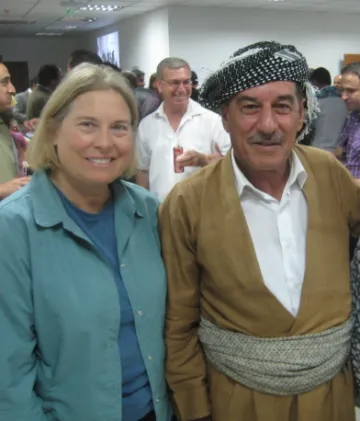
Odegaard with the Kurdistan Cultural Minister in 2010. Photo by Scott Carrlee.
___________________________________
International Impact
Odegaard’s renown extends well beyond the United States. Her international work has taken her to all continents except Antarctica. Some of her international work includes the following:
In 1989, she was an AIC/People to People delegate to China and was awarded Fulbright scholarships in Costa Rica (1991), Dominican Republic (2001), and Colombia (2017), as well as residency scholarships at the Canadian Conservation Institute (1995), Winterthur Library (2000), Getty Conservation Institute (2007), and the International Center for Conservation in Rome (2015).
In 2009, Odegaard was part of the conservation team that advised the Ethiopian government on the treatment of the 3.2M-year-old fossil known as “Lucy,” and she devised the transport preservation method and a protective case in which the hominid remains could be shipped for a traveling exhibit entitled, Lucy’s Legacy: The Hidden Treasures of Ethiopia.
In 2010, Odegaard traveled to Erbil, Kurdistan, as part of the U.S. Department of State’s Iraq Cultural Heritage Project, which aimed to advance professional standards and practices among heritage and museum professionals in Iraq’s cultural institutions. As an advisory board member, she continues to provide expert training at the Iraqi Institute for Conservation of Antiquities and Heritage.
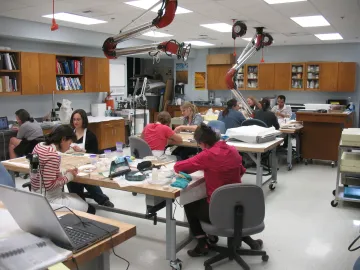
The ASM conservation lab is a hub of research, teaching, and outreach.
___________________________________
Future Plans
Though retired, Odegaard has been awarded emerita status and will continue to conduct research, provide training, assist students, and lecture extensively throughout the world. In addition to ASM, there is a long list of conservation programs, researchers, and students eager to continue to benefit from her expertise.
When asked in what direction she would like to see the discipline go, she answered, “I’d like to see conservators continue to bring science and culture together. I believe the field of conservation can play an important role in the interdisciplinary study of heritage. While the field will continue to research the physical aspects of objects and how to preserve them, conservators can collaborate with others to better understand the social contexts of traditional technologies and together develop strategies to provide for the long-term protection of cultural heritage.”
As for the museum, according to Director Lyons, “ASM will honor Nancy’s legacy by striving to follow her example. We intend for conservators to continue teaching, researching, and innovating. To help ensure all that, thanks to the generosity and vision of Susan and Glynn Thickett, an endowment fund has been established in Nancy’s honor. The more we can grow that fund, the more secure the lab’s future will be, and the more Nancy’s legacy will be honored. I invite everyone who wishes to express appreciation for Nancy do so by contributing to this fund.”
Give a Gift in Nancy’s Honor
Gifts to ASM’s Conservation Laboratory Endowment Fund can be made in honor of Dr. Odegaard. The fund was established in 2017 by Susan and Glyn Thickett to honor Nancy’s legacy and to ensure financial support for the work of her successors.
Gifts can be made online at https://give.uafoundation.org/arizona-state-museum. Choose “ASM Conservation Laboratory Endowment Fund” from the dropdown menu.
Checks, payable to “UA Foundation/ASM” and with “conservation endowment” written in the memo line, can be mailed to:
Arizona State Museum
Office of Development
PO Box 210026
Tucson, AZ 85721-0026





